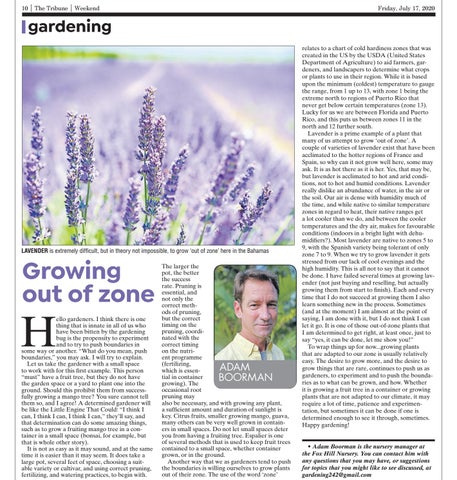10 | The Tribune | Weekend
Friday, July 17, 2020
gardening
LAVENDER is extremely difficult, but in theory not impossible, to grow ‘out of zone’ here in the Bahamas
Growing out of zone
H
ello gardeners. I think there is one thing that is innate in all of us who have been bitten by the gardening bug is the propensity to experiment and to try to push boundaries in some way or another. “What do you mean, push boundaries,” you may ask. I will try to explain. Let us take the gardener with a small space to work with for this first example. This person “must” have a fruit tree, but they do not have the garden space or a yard to plant one into the ground. Should this prohibit them from successfully growing a mango tree? You sure cannot tell them so, and I agree! A determined gardener will be like the Little Engine That Could: “I think I can, I think I can, I think I can,” they’ll say, and that determination can do some amazing things, such as to grow a fruiting mango tree in a container in a small space (bonsai, for example, but that is whole other story). It is not as easy as it may sound, and at the same time it is easier than it may seem. It does take a large pot, several feet of space, choosing a suitable variety or cultivar, and using correct pruning, fertilizing, and watering practices, to begin with.
The larger the pot, the better the success rate. Pruning is essential, and not only the correct methods of pruning, but the correct timing on the pruning, coordinated with the correct timing on the nutrient programme (fertilizing, which is essential in container growing). The occasional root pruning may also be necessary, and with growing any plant, a sufficient amount and duration of sunlight is key. Citrus fruits, smaller growing mango, guava, many others can be very well grown in containers in small spaces. Do not let small spaces deter you from having a fruiting tree. Espalier is one of several methods that is used to keep fruit trees contained to a small space, whether container grown, or in the ground. Another way that we as gardeners tend to push the boundaries is willing ourselves to grow plants out of their zone. The use of the word ‘zone’
relates to a chart of cold hardiness zones that was created in the US by the USDA (United States Department of Agriculture) to aid farmers, gardeners, and landscapers to determine what crops or plants to use in their region. While it is based upon the minimum (coldest) temperature to gauge the range, from 1 up to 13, with zone 1 being the extreme north to regions of Puerto Rico that never get below certain temperatures (zone 13). Lucky for us we are between Florida and Puerto Rico, and this puts us between zones 11 in the north and 12 further south. Lavender is a prime example of a plant that many of us attempt to grow ‘out of zone’. A couple of varieties of lavender exist that have been acclimated to the hotter regions of France and Spain, so why can it not grow well here, some may ask. It is as hot there as it is her. Yes, that may be, but lavender is acclimated to hot and arid conditions, not to hot and humid conditions. Lavender really dislike an abundance of water, in the air or the soil. Our air is dense with humidity much of the time, and while native to similar temperature zones in regard to heat, their native ranges get a lot cooler than we do, and between the cooler temperatures and the dry air, makes for favourable conditions (indoors in a bright light with dehumidifiers?). Most lavender are native to zones 5 to 9, with the Spanish variety being tolerant of only zone 7 to 9. When we try to grow lavender it gets stressed from our lack of cool evenings and the high humidity. This is all not to say that it cannot be done. I have failed several times at growing lavender (not just buying and reselling, but actually growing them from start to finish). Each and every time that I do not succeed at growing them I also learn something new in the process. Sometimes (and at the moment) I am almost at the point of saying, I am done with it, but I do not think I can let it go. It is one of those out-of-zone plants that I am determined to get right, at least once, just to say “yes, it can be done, let me show you!” To wrap things up for now...growing plants that are adapted to our zone is usually relatively easy. The desire to grow more, and the desire to grow things that are rare, continues to push us as gardeners, to experiment and to push the boundaries as to what can be grown, and how. Whether it is growing a fruit tree in a container or growing plants that are not adapted to our climate, it may require a lot of time, patience and experimentation, but sometimes it can be done if one is determined enough to see it through, sometimes. Happy gardening! • Adam Boorman is the nursery manager at the Fox Hill Nursery. You can contact him with any questions that you may have, or suggestions for topics that you might like to see discussed, at gardening242@gmail.com








